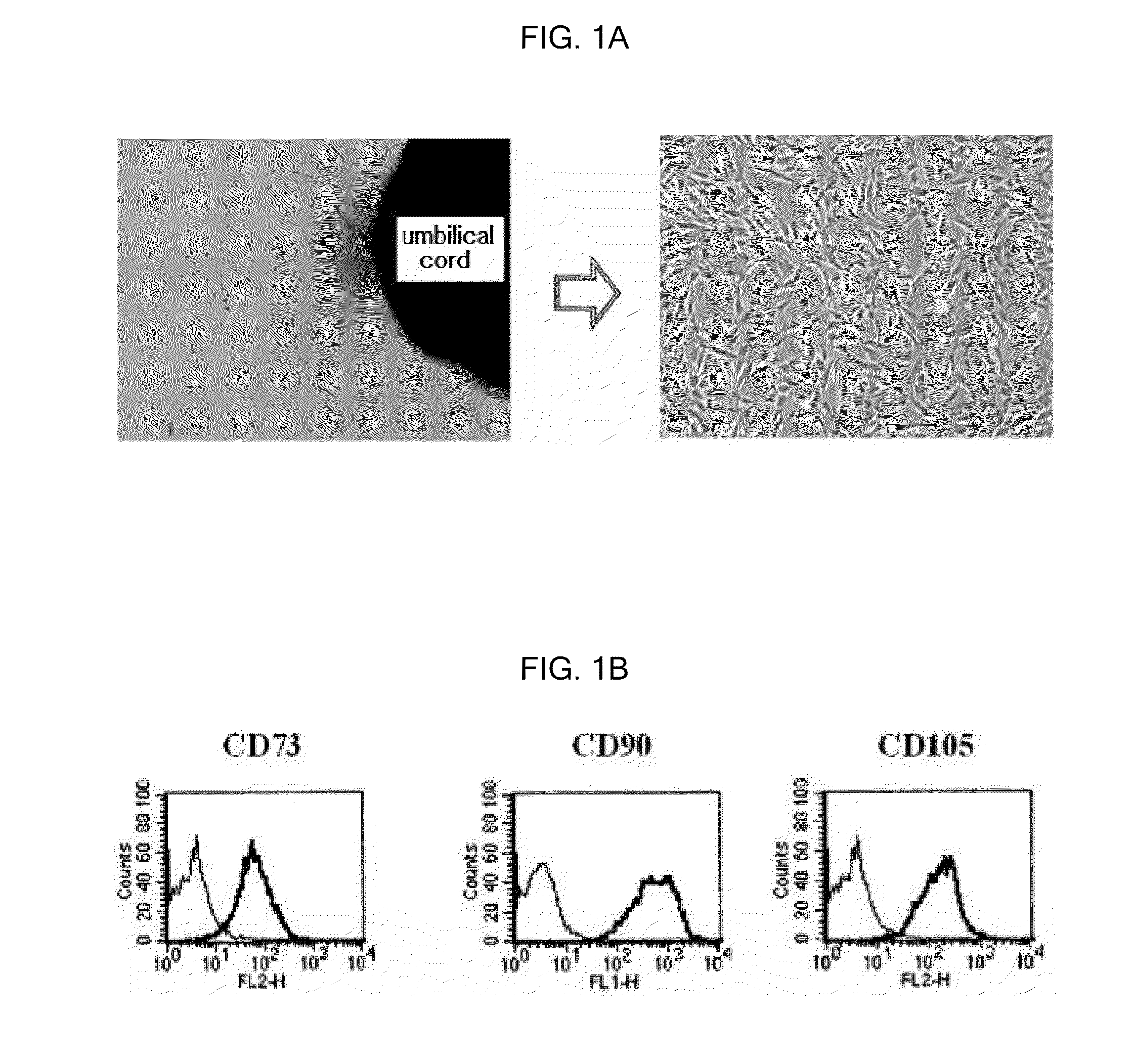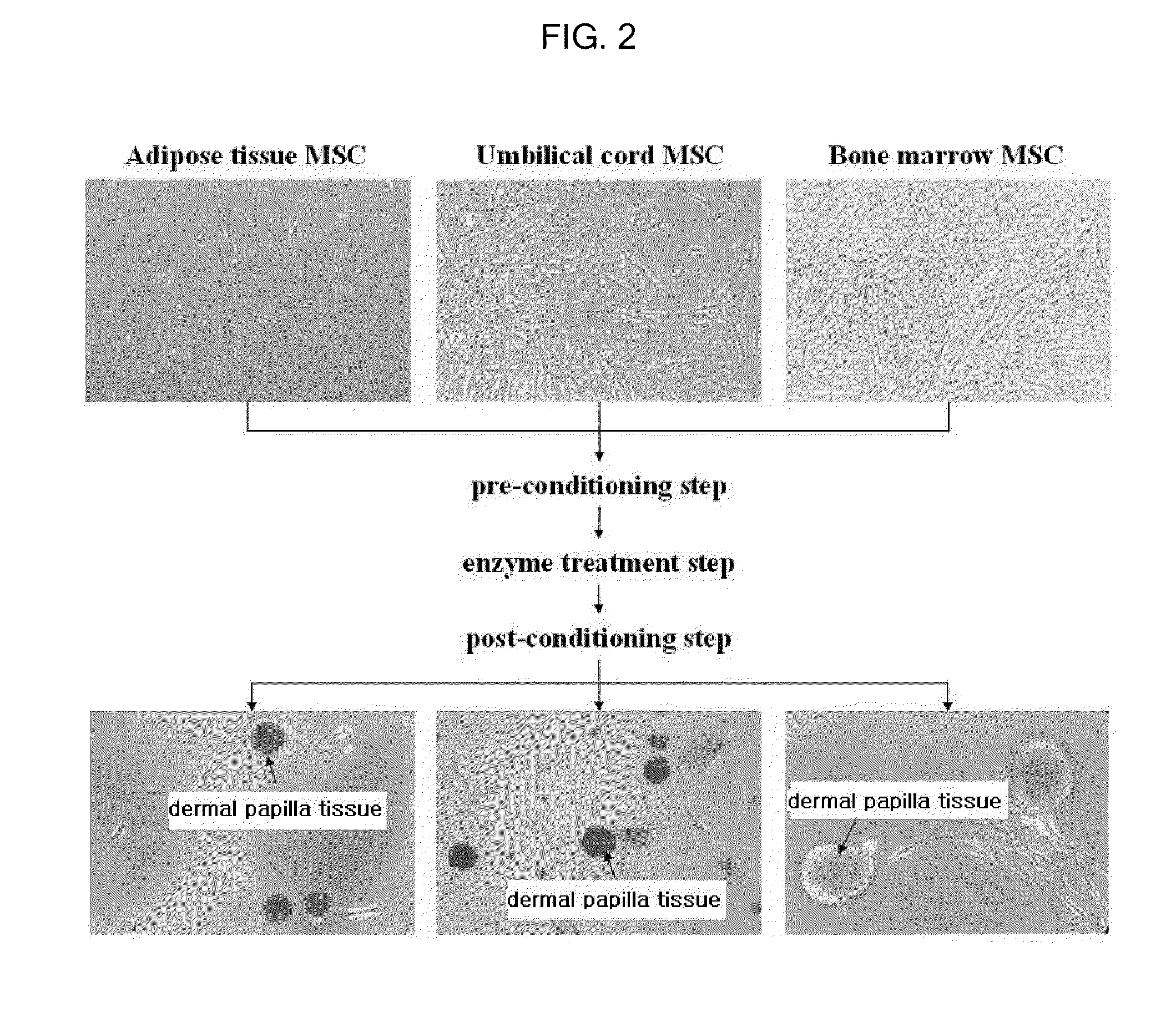Method For The Preparation Of Dermal Papilla Tissue Employing Mesenchymal Stem Cells
- Summary
- Abstract
- Description
- Claims
- Application Information
AI Technical Summary
Benefits of technology
Problems solved by technology
Method used
Image
Examples
preparation example 1
Preparation of a Secondary Culture Medium
[0040]One liter of a medium containing higher concentration, of amino acids and vitamins than conventional culture media was prepared according to the composition described in Tables 1a to 1d, and 10 mg / l of insulin, 10 mg / l of transferrin, 0.01 mg / l of sodium selenite, 10 μg / l of hydrocortisone, and 0.2 weight % of albumin (2 g / l) were added thereto, to prepare a secondary culture medium.
TABLE 1aInorganic salts (mg / l)CaCl2165CuSO4•5H2O0.0001Fe(NO3)•9H2O0.0001KCl330KNO30.076MgSO498MnCl2•4H2O0.0001NaCl4800NaHCO33360Na2HPO4111ZnSO4•7H2O0.0002
TABLE 1bOther ingredients (mg / l)D-glucose2000Sodium pyruvate110HEPES2383Phenol red15
TABLE 1cAmino acids (mg / l)L-alanine50L-arginine100L-asparagine50L-aspartic acid60L-cystine•2HCl182.4L-glutamic acid150L-glutamine584L-glycine60L-histidine62.1L-isoleucine210L-leucine210L-lycine•HCl292L-methionine60L-phenylalanine132L-proline80L-serine84L-threonine190L-tryptophan32L-tyrosine208L-valine188
TABLE 1eVitamins (mg / ...
example 1
Obtainment of Mesenchymal Stem Cells
[0041]Umbilical cord obtained during parturition was washed 3 times with phosphate buffer, and the smooth muscle area around blood vessels and the epithelial layer were removed therefrom. The remaining Wharton jelly layer was cut into small pieces of about 3 mm×3 mm in size and the pieces were placed on a culture dish, and in an incubator maintained at 37° C. for about 4 hours until the pieces adhered to the bottom of the culture dish. Then, DMEM (Dulbecco's Modification of Eagle's Medium) supplemented with 10% FBS was added to the culture medium. 1 week thereafter, cells began to flow out from the Wharton jelly of the umbilical cord, and when the cells occupied about 80% of the bottom of culture dish, the medium was shifted to a new medium in which the cells were sub-cultured. When the cells grew to occupy about 70% of the culture dish, the medium was treated with 0.05% trypsin / 0.02 EDTA to detach the cells from the culture dish and adjusted the ...
example 2
Preparation of a Dermal Papilla Tissue
[0044]Mesenchymal stem cells originated from bone marrow, adipose tissue and umbilical cord obtained in Example 1 were respectively subjected to a monolayer culture in DMEM supplemented with 10% FBS until the cells occupied about 80% of the culture dish. Then, the culture medium was replaced with a secondary culture medium which is a serum-free high concentration medium prepared in Preparation Example 1, and 20 ng / ml of HGF (rhHGF, R&D system) was added thereto. The medium was replaced with a fresh medium at about 3-day intervals, and 3 weeks thereafter, the culture was treated with trypsin in an amount ranging from 20 to 40 μl / cm2 to detach the cells from the culture dish. Cell aggregation began to take place from about 24 hours after treating with trypsin, and the completely aggregated cell mass became suspended in the medium. The suspended cell aggregates were isolated from the culture using centrifugation at 500 rpm for 3 min. The cell aggre...
PUM
 Login to View More
Login to View More Abstract
Description
Claims
Application Information
 Login to View More
Login to View More - R&D
- Intellectual Property
- Life Sciences
- Materials
- Tech Scout
- Unparalleled Data Quality
- Higher Quality Content
- 60% Fewer Hallucinations
Browse by: Latest US Patents, China's latest patents, Technical Efficacy Thesaurus, Application Domain, Technology Topic, Popular Technical Reports.
© 2025 PatSnap. All rights reserved.Legal|Privacy policy|Modern Slavery Act Transparency Statement|Sitemap|About US| Contact US: help@patsnap.com



